Abstract
This study aims to assess the quantitative and, above all, the qualitative potential of the agricultural labour force in Romania. In the first part of this paper, analyses will be carried out on the agricultural labour force to identify the potential of countries that attach particular importance to the subject studied and the inter-relationships between them, where agriculture is a major employer. In the second part of the paper, an empirical analysis of labour force statistics will be carried out to assess its potential, both quantitatively and qualitatively. Finally, we want to determine the influence of certain population characteristics on the qualitative potential of the labour force. The bibliometric analysis provides a historical, contextual and evolutionary perspective on previous research and problematic factors in the field, linking the “agricultural labour force” to other issues such as climate change, economic growth, sustainability, education and income. It provides a comprehensive framework and links between the various elements influencing the agricultural sector, strengthening the understanding of the interconnections between labour force and other key variables in the sector.
1. Introduction
The agricultural labour force refers to the number of people working in the sector, including farmers, seasonal workers and permanent employees [1].
As well as playing an important role in the food supply, the agricultural sector can also play an essential role in a country’s economic and social development by creating employment opportunities and stimulating the rural economy. Agriculture can also be a great source of income for farmers and workers in the sector [2,3,4].
However, the agricultural workforce can face harsh working conditions and low levels of security and social protection. In addition, agriculture can be affected by factors such as climate change, economic and political crises, limited access to technology and finance [5].
The agricultural workforce in Romania is characterised by a predominantly elderly population, where approximately 59.2% of employees are between the ages of 40 and 64, and 9% are aged 65 or over. Young people comprise only a small part of the labour force—about a third of the total. Farm managers under 40 make up only 10.4% of their total number. In addition, family farms dominate the agricultural market, accounting for 92.2% of all farms and managing 62.2% of the total area of agricultural land used [5].
Governments and the agricultural sector must therefore work together to ensure adequate working and living conditions for the farmers and to support and develop the agricultural sector so that it can provide food and resources to the population in a sustainable way [6,7,8].
Affected by factors such as the automation, mechanisation and transfer of labour to more attractive cities and industries, and the ageing of the rural population, Romania’s agricultural labour force has been shrinking in recent years, a fact which led to a reduction in the number of farmers and agricultural workers. Efficiency and productivity gains in different fields are often associated with extensive discussions about mechanisation and automation. However, little attention is paid to the vital interaction between technological advancement and the high level of training of the workforce, an essential connection for optimising performance and efficiency. This observation highlights a gap in the current debate, neglecting the synergistic potential of investing in both technology and employee skill development to maximise economic outcomes and improve performance within the industry [9,10]. Despite changes in the economy, agriculture continues to play a vital role in Romania’s economy, making a significant contribution to the country’s gross domestic product and providing essential food and resources for the population [11,12,13]. The Government of Romania and the agricultural industry are working together to support and attract young people to join the industry through technology and infrastructure investment programmes and initiatives, as well as the provision of training and education in the field [14,15].
Furthermore, Romania boasts a rich agricultural tradition and a diverse range of high-quality agricultural products, coupled with tremendous potential for further development in this sector. Agriculture remains an equitably component of the Romanian economy, serving as a primary source of food for the domestic market and a key contributor to the global export of agricultural products. In recent years, Romania’s agricultural sector has been marked by reform and modernisation, including the usage of modern technologies and sustainable farming practices. However, there are still issues of under-investment, insufficient infrastructure, and the need to improve competitiveness in European and world markets. The potential of farms is affected by water and irrigation services, which are insufficient or non-existent in some areas.
Romania’s agricultural sector has continued to develop in recent years, but efficiency and productivity problems remain. Limited access to finance and red tape affect farmers’ ability to reorient themselves towards innovation and new modern technologies. Despite these problems, the Romanian government has taken measures to support the agricultural sector, including not only the provision of subsidies but also specialised programs in technology and innovation [16].
The European Union supports agriculture through policies and programs designed to increase agricultural productivity and competitiveness, but issues of an independent nature such as natural resources, environmental change and the shift towards sustainable agriculture have emerged. This has led to high environmental standards for animal and food safety, with positive effects on food safety and product quality but also negative effects such as increased costs for farmers and competition on the world market [17].
The current trend in the European Union shows a decrease in the number of people involved in agricultural activities, which on the one hand has positive aspects such as increasing labour productivity and farm size, and on the other hand, is negative due to ageing farmers and the rural population, especially young people, who migrate to urban environments or abroad where they receive job offers that are more enticing than those of the EU. The EU is also diverse when it comes to forms of employment (part-time or full-time), but also in terms of income received (paid and unpaid), age and gender structures, levels of education and productivity [18]. In the European Union, family-type farms make up 95.2% of all farms, which manage 62.2% of the entire used agricultural area and contribute to 59.5% of all agricultural production. Farms where the activity is exclusively provided by members of the farmers’ families are the smallest and have the lowest average labour force and the lowest average standard output in the field of agriculture. As such, learning plays an essential role for a society that is constantly changing and where farmers must adopt new technologies and innovative sustainable practices to maintain the performance and competitiveness of the agricultural sector [5].
As the number of agriculture workers decreases in the EU, the need for skilled workers is increasing due to quality standards. Young people are attracted to this field through various training and assistance programmes for farmers. Regulations on wages and working conditions have also evolved/been updated with these changes.
In addition, the Common Agricultural Policy (CAP) aims to ensure a high level of food production, improve working conditions and contribute to environmental sustainability [19,20].
Further, by studying the existing literature on the topic of labour force performance in agriculture, the thematic framework for the present research can be outlined.
According to recent studies, the critical situation facing this sector is established, both in Romania and in other European countries. These studies mention that employment has shown a pattern of decline in recent years, but in agriculture, the decline is 50% faster than in other sectors (such as tourism, as noted by some authors) [21,22,23].
Therefore, given the situation faced by the agricultural sector at the European level, including in Romania, coupled with a decrease in the volume of the labour force and the problem of an ageing population and the migration of young people from rural areas [24,25,26,27], intensive development in this sector is necessary. At the same time, given the studies presented above, it can be considered that intensive development can be achieved only by increasing productivity, so that a smaller labour force can create and develop more production value and/or added value, and according to the latest studies presented, this increase in productivity, in addition to technical and technological endowment [28,29], can be achieved by increasing the educational level of human capital. With globalisation, agriculture in many countries has undergone significant changes, transforming into export-oriented production that is becoming increasingly dependent on migrant labour. This workforce often faces disadvantageous conditions related to low wages, limited social protection, difficulties in obtaining housing and restricted access to health services. However, there are countries such as Spain, Italy and Poland where agriculture is an important economic sector for generating jobs, supporting sustainability and revitalising rural areas [30,31].
Other research confirms that Romania is at the bottom of the rankings in terms of labour productivity in agriculture, but nevertheless, as early as 2017, there were positive signs, such as an increase in labour productivity of over 50% in terms of the value of agricultural output per person employed [26]. Thus, it can be considered that Romania’s position can improve with an increase in labour productivity, even with a decrease in the volume of labour in agriculture [32]. According to research estimating production functions for specific regions in Greece, it was found that human capital shows a strong positive association with labour productivity through upper secondary and tertiary education, while primary education shows a negative relationship, and lower secondary education shows no association with productivity [27].
The objective of this study is to conduct an in-depth examination of Romania’s agricultural sector, focusing on both quantitative and qualitative aspects of its workforce. Specifically, this research seeks to ascertain the impact of educational levels within the labour force on key performance indicators within the agricultural domain. This investigation will employ a two-pronged approach, firstly, through a comprehensive bibliometric analysis of pertinent research topics in this area and, secondly, by scrutinising data concerning labour force demographics and capacity. Ultimately, the study aims to establish correlations between various labour force attributes and outcome indicators, providing a nuanced assessment of the labour force’s potential within the agricultural sector.
The research question for this article focuses on human resources and influence on agricultural economic activity Thus, the question arising from this context is “to what extent does the qualitative potential (level of qualification/training/education) of the population employed in agriculture influence the value level of agricultural production?”
According to the research presented, there is a general trend at the Member State level of a shrinking workforce due to the level of modernisation and digitisation of agricultural production, reducing the need for labour. In this respect, the first research hypothesis to which the paper wishes to contribute is that (H1) “the Romanian agricultural labour force is declining at an accelerated rate”, given that, in addition to the modernisation of production technologies, there is also a reduced level of labour availability and a marked ageing of the rural population.
Given the research on the relationship between wage earnings and job vacancies [33] and the trend in Romania [34], we consider the second hypothesis (H2) in which wage earnings inversely influence the number of job vacancies in agriculture.
Considering the increasing dynamics of agricultural production, we consider in the third research hypothesis (H3) that this increase may also be influenced by the higher level of education among the population employed in agriculture, which may represent the qualitative potential of the labour force.
2. Bibliometric Analysis on “Agriculture Labour Force”
To develop the bibliometric analysis, the data collected from the Web of Science database on the topic “agriculture labour force” was entered into VosViewer software, version 1.6.18, through which maps were generated on keywords used at least five times in, scientific paper, their usage by year and countries that give particular importance to the studied topic. This paper presents a bibliometric analysis based on a sample of 1367 articles on the agricultural labour force. Regarding the methodology of the literature review, it was based on a meta-analysis.
According to the Web of Science database, between 1975 and 2022, a total of 1367 scientific papers were produced on the subject “agriculture labour force” in categories such as economics (283 papers), environmental science (218 papers), environmental studies (166 papers), agricultural economics policy (98 papers), development studies (88 papers), green sustainable science and technology (83 papers), etc.
This topic started to be researched as early as 1975, when two scientific papers were produced. The maximum number of papers produced in this field was in the year 2021 with 159 papers, which then decreased to 150 papers the following year (Figure 1).
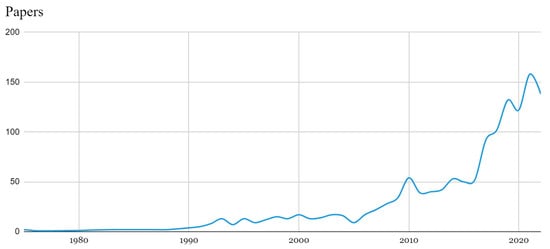
Figure 1.
Evolution of the literature written on the subject “agriculture labour force”. Source: processed from the Web of Science website.
In terms of countries with the most publications in the Web of Science database, the USA (473 papers) is in first place, followed by China (460 papers) and England (106 papers). Romania ranks 14th with 46 papers on the subject analysed, which shows that it attaches importance to this subject due to its impact on the economy.
In China, the workforce in the agricultural sector is significant, but in recent years, it has declined due to industrial growth and urbanisation, so young people are reorienting towards industry instead of agriculture. Also, in the United States, the agricultural labour force has declined, with the main reasons being automation and mechanisation, which have significantly reduced the human labour force [20,35] (Figure 2).
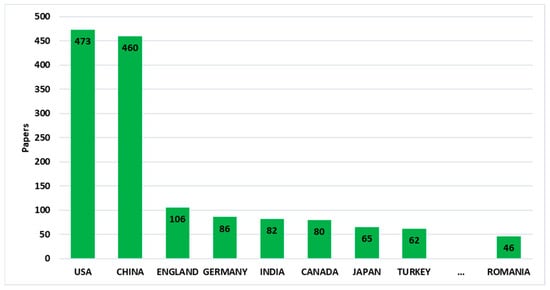
Figure 2.
Top countries with most papers on “agriculture labour force”. Source: processed from the Web of Science website.
According to the Web Of Science database, the top 10 categories in which most scientific papers were included are economics (283 papers), environmental sciences (218 papers), environmental studies (166 papers), agricultural economic policy (98 papers), development studies (88 papers), green sustainable science and technology (83 papers), multidisciplinary agriculture (82 papers), history (81 papers), geography (65 papers) and sociology (61 papers) (Figure 3).
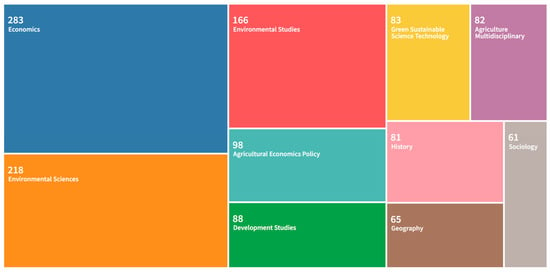
Figure 3.
TreeMap chart on “agriculture labour force”. Source: processed from the Web of Science website.
In Figure 4, the words interdependent of the subject studied are shown, the most important ones being represented by the following: agriculture, self-employment, entrepreneurship, rural, financial development, urbanisation, industrialisation, climate change and economic growth.
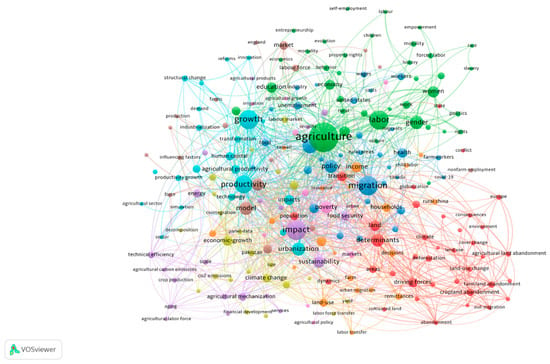
Figure 4.
Linking “agriculture labour force” with other related terms. Source: authors’ own processing based on WoS results using VOSviewer.
These words are grouped into clusters and represent the words that researchers use in various scientific papers. Thus, the first cluster (red), called “determinants”, presents the problematic factors facing agriculture, such as climate, conservation, land, areas, diving force, land-use change, household, consequences, abandonment, farmland abandonment, environment, out-migration, cultivated land, globalisation, conflict, cover change and conservation.
The second cluster (green), called “agriculture”, presents subjects that are important to monitor and have an impact on the agricultural sector: labour, gender, work, women, labour force participation, economy, behaviour, investment, education, culture, evolution, entrepreneurship, self-employment, labour, mobility, race, slavery, rural, politics, rights and poverty.
The third cluster (dark blue), called “migration”, includes health, policy, costs, wages, workers, employment, rural areas, immigration, patterns, industry, COVID-19 and farm workers.
The fourth cluster (yellow), called “economic growth”, includes topics that directly influence economic growth such as access, climate change, CO2 emissions, adaptation, labour force transfer, variability, financial development, agricultural production, de-composition, size and panel data.
The fifth cluster (purple), called “impact”, includes sustainability, agricultural mechanisation, ageing, energy, technical efficiency, crop production, agricultural labour force, services, scale, irrigation and food security.
The sixth cluster (light blue), called “growth”, includes transformation, human capital, structural change, urbanisation, technology, demand, industrialisation, reforms and innovation.
The seventh cluster (orange), called “income”, includes farms, urban migration, land use, remittances, households, rural China and child labour (Figure 4).
Analysing the keywords used by researchers over the years shows that:
- From 2012 to 2015, researchers were concerned with the economy, reforms, costs, rural, food, farms, industrialisation, productivity growth, growth, unemployment, behaviour, markets, costs and entrepreneurship;
- In 2016 and 2017, the focus was on agriculture, work, economic growth, gender, woman, land, determination, sustainability, politics, income, transition, poverty and household;
- Later in 2018–2020 the focus shifted to impact, productivity, farmland abandonment, cropland abandonment, land use, agricultural mechanisation, agricultural product, financial development, sinking force, technical efficiency, pattern, urbanisation, migration, health, forced labour, slavery, carbon emissions in agriculture, scale, CO2 emissions and technology (Figure 5).
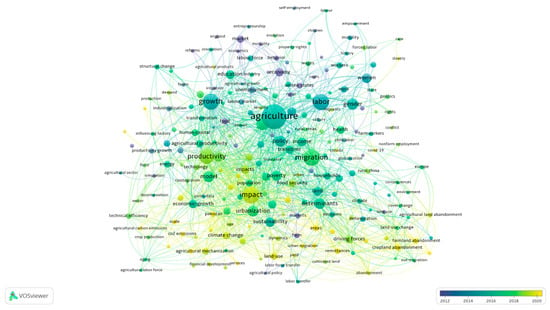 Figure 5. Linking “agriculture labour force” to other related terms by year. Source: authors’ own processing based on WoS results using VOSviewer.
Figure 5. Linking “agriculture labour force” to other related terms by year. Source: authors’ own processing based on WoS results using VOSviewer.
The importance of country relationships is crucial for identifying the relevant countries in the scope of our study. Therefore, the frequency of collaborations and partnerships between institutions are represented as nodes on our map. Variations in colour indicate the diversity of research directions, while the thickness and distance of connections reflect the level of collaboration and interaction between countries.
China, the United States and England demonstrate a distinct focus on this subject matter. The map presented delineates eight discernible research trajectories within this domain, characterised by distinctive colour patterns. Moreover, the European Union exhibits a keen interest in this topic, evidenced by countries like Slovakia, Greece, Sweden, Finland, and Austria pursuing similar research directions. Given the diverse economies of EU member states and the significance of this sector, coupled with escalating research investments and a burgeoning scientific trend at the EU level, there is a noticeable uptick in the volume of papers dedicated to this subject (Figure 6).
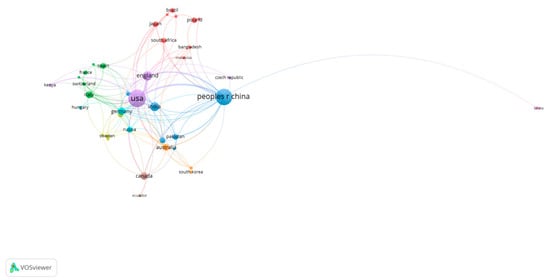
Figure 6.
The link between co-author countries. Source: authors’ own processing based on WoS results using VOSviewer.
3. Materials and Methods
In the first part of the Results section, the main socio-economic aspects of the labour force and human development in Romanian agriculture will be investigated from a statistical point of view.
In the second part of the Results section, the quantitative and qualitative analyses carried out on data on the agricultural labour force provided by national databases (National Statistical Institute) and international databases (Eurostat) will be discussed. Data on the population employed in agriculture, the level of average monthly earnings, job vacancies available and the level of education of the employed population were identified (Table 1). Finally, a regression analysis was carried out to determine the influence that the level of education of the population employed in agriculture (exogenous variable) may have on the effect indicator value of agricultural production (explained variable).

Table 1.
Description of the variables used in the research.
Variables were chosen based on the availability of data in both national and European databases and on previous empirical research on the literature.
The development of the econometric model will be carried out using EViews Student Version: 12.
4. Results
We believe that ensuring Romania’s food security and orienting agriculture towards a sustainable sector of the economy cannot be conceived without an analysis of the workforce in agriculture; its professional quality; the structure by age group; and, last but not least, the economic, social and professional status [36].
4.1. Statistical–Economic Analysis of Labour Force and Human Resources Development in Romanian Agriculture
As a general approach, the labour force is at the confluence of demography, economy and society: demographically [37] because over time, 10–15 years on average, demographic phenomena and processes predetermine the volume of labour resources, i.e., the potential demand for jobs, a demand strongly structured by age, sex, profession, level of education and training, territory, etc.; economically [37] because the economy, depending on a series of factors and conditions which differ widely in nature (technical or organisational), determines the number and structure of jobs, the overall and structural volume of supply and the potential for employment; and socially [37] because the human factor should be at the heart of any development strategy as its end in itself, as an economic agent, as the carrier of the investment process, as the accumulation of capital in the form of knowledge and education, as an inexhaustible resource with unlimited creative powers, etc. [37].
Human resources in agriculture can be considered as an independent variable, and in this case, we will use the following indicators: number of total population and civilian employed population in agriculture. The civilian employed population in agriculture can be considered as the outcome variable, which means that we will present the ratio of the employed population in agriculture to the civilian population (Table 2).

Table 2.
Civilian employed population * in agriculture in Romania (%).
At the national level, 42.4% of the employed civilian population is employed on average, of which agriculture accounts for 20.7%, and industry, for 22.8% (Table 2, column 11).
Figure 7 shows the dynamics of the population employed in the agricultural sector as well as in the industrial sector, comparing the growth rate using the linear model.
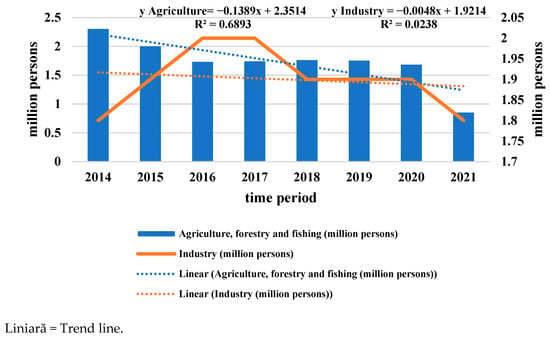
Figure 7.
Civilian employed population by activities of the national economy. y Agriculture = the value of the regression trend function for the population employed in agriculture, forestry and fishing; y Industry = the value of the regression trend function for the population employed in industry.
Coefficient b of the regression equation shows a quantitative decrease in the civilian population employed in agriculture, on average, by 0.139 million persons/year (average growth rate −13%), while the civilian population employed in industry decrease on average by 0.0048 million persons/year.
The agricultural human resource density indicator is calculated as the ratio of the total population to agricultural industry output and utilised agricultural area. According to our calculations for this indicator, in Romania, one person working in agriculture produces goods, on average, for 15 inhabitants; works, on average, 10 hectares; and obtains agricultural goods and services at an average value of 14.3 thousand euros per year, which is equivalent to an average of 1189 euro/month. We consider this amount to be very low for a person working in agriculture, and here, we take into account the possible expenses that go into the maintenance and needs of a family. It has been taken into account that a family includes parents and a child (i.e., three people) (Table 3, column 12).

Table 3.
Agricultural labour force density in Romanian agriculture.
Compared to other European Union countries, in 2022, the country’s population was 19.2 million, with Romania ranking sixth by population size (after Germany (83.1 million inhabitants), France (67.6 million inhabitants), Italy (59.2 million inhabitants), Spain (47.3 million inhabitants) and Poland (37.8 million inhabitants); fourth in terms of utilised agricultural area (UAA), after Spain (24.4 million hectares), Germany (16.6 million hectares) and Poland (14.5 million hectares); seventh place in the value of production at basic prices, after France (EUR 96.6 million), Germany (EUR 74.5 million), Italy (EUR 71.2 million), Spain (EUR 63.2 million), Poland (EUR 39.9 million) and the Netherlands (EUR 36.2 million); and third place in the EU in the agricultural labour force, after Poland (1.43 million AWU) and Italy (1.02 million AWU).
The essential factor in the economic and social development of agriculture is the human resources available to it at any given time. In this context, labour resources are identified by the number, experience and degree of training.
The statistical data show, in part, how the agricultural requirement of the future fits in, in that average annual growth rates are observed for the university level of education (+5.84%) and for the high school level (+1.87%). A considerable reduction is recorded at the secondary school level (−10.78%), at the primary school level (−16.23%) and at the level of those with no schooling (−6.42%), as shown in Table 4, column 7. A deterioration in the level of education is observed in rural areas. The causes are due to the standard of living and quality of rural life. Declining education rates for the mentioned levels will have repercussions on future generations entering the labour force, with negative effects on labour efficiency and productivity. Such phenomena represent long-term obstacles to the formation of high-performance and competitive agriculture [38]. The agriculture of the future needs a new type of farmer, who must be a good agronomist and animal scientist, a better plant protection specialist, a better financial analyst, a better computer scientist and a better marketing specialist [38].

Table 4.
The employed population by education level in rural areas (thousand people), in the period 2014–2022.
The development of human resources and the contribution that education makes to increasing the productivity of the world has been the subject of research by several leading economists. Adam Smith in The Wealth of Nations included fixed capital as the most acquired and useful skills of all the inhabitants or members of society. Alfred Marshall wrote that “The most valuable of all capitals is that invested in human beings”. Schultz was a pioneer in the study of investment in human capital. Drawing attention to the importance of human resource development, he emphasised the relative returns from investment in education. The failure to treat human resources explicitly as a form of capital, as a means of production produced, and as a product of investment, encouraged the classical notion of labour as a capacity to perform manual work requiring little knowledge and skill, a capacity with which, according to this notion, workers are roughly equally endowed [39].
Employed population by age group: compared to urban areas, the rural area shows a decrease in the employed population by an average of 2.35 percentage points. This situation can be explained by the phenomenon of village and rural migration, but also by people leaving to work in other countries. The factors of migration are push factors (low living standards, poverty, lack of employment, financial and political crises, etc.) and pull factors (higher living standards, higher wages, the possibility of finding a better job, experience of social networks, individual freedom, etc.) [40].
Overall, the data are statistically homogeneous, with a coefficient of variability below 10% (CV < 10%), except for the 65+ age group, where there is statistical heterogeneity in the data (CV > 30%). The largest employed population belongs to the 35–49 age group and the 50–65 age group, as shown in Table 5, column 4, rows 6 and 7. In terms of the annual growth rate, it could be interpreted as significantly negative for the age groups of 15–24 years (−2.50%), 25–34 years (−2.25%), 35–49 years (−2.09%) and very significantly negative for the age group of 65 years and over (−20.72%). From an occupational point of view, the trend of a very significant reduction in the age group of 65 years and over (−20.72%), identified in the literature as the phenomenon of demographic and demo-economic ageing, can be explained by the transfer of land use rights to descendants, leasing, renting, selling land but also due to the inability to be competitive, as shown in Table 5, columns 3, 6 and 7.

Table 5.
The employed population by age group in rural areas, 2014–2022 (thousand people).
According to statistical data, for the period of 2014–2022, Romania’s employed population is on average 8.41 million people, of which 55.8% (4.689 million people) represent the urban population, and 44.2% (3.721 million people) represent the rural population. Agriculture, forestry and fishing represent on average 20.7% (1.762 million persons) of the total employed population, with the distribution by residence being 8.7% in urban and 91.3% in rural areas (Table 6).

Table 6.
Population employed in agriculture in rural areas, by professional status, 2014–2022 (thousand people).
The population employed in agriculture in rural areas fell by 4.43 percentage points compared to the urban employed population. There was an increase among employers working in agriculture (+10.36%) and employees (+1.11%). The employed population in Romania decreased, on average, by 1.27%, and the employed population in agriculture is 10.89 percentage points lower than the national average. A significant share of the employed population in agriculture has decreased significantly for the categories of own-account workers (−12.29%) and unpaid family workers (−17.24%). The reduction in these categories primarily affects the labour stock in rural areas. We tend to believe that this decline was driven by economic reasons, generated by low incomes from agriculture. An illustrative example would be the income from agricultural factors [41] obtained by Romania compared to other EU-27 countries. Thus, for the period of 2014–2020, Romania obtained an average income of 4100 EUR (in real terms)/AWU compared to France (33030 EUR/AWU), Spain (35915 EUR/AWU), Germany (29149 EUR/AWU), Italy (21397 EUR/AWU) and Poland 6200 EUR/AWU, with Romania being in the last place in the EU-27.
Romania’s agricultural labour force [3] is a category that even includes people who work seasonally and for free, and this applies to members of farming families. The amount of labour provided can be converted into full-time labour equivalents (annual work units) to understand the amount of work carried out in agricultural activities (Table 7).

Table 7.
Agricultural labour input statistics (AWU) in Romania, 2014–2022.
Figure 8 shows a comparison of the labour force in Romania’s agriculture between salaried and unsalaried persons.
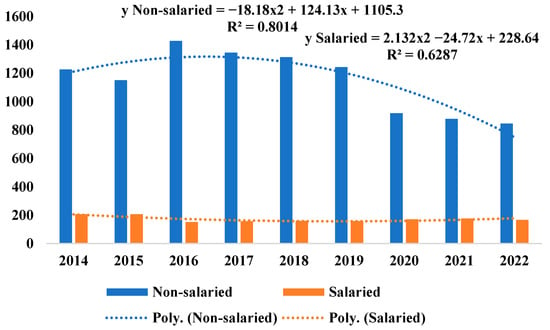
Figure 8.
Agricultural labour input statistics (AWU) in Romania. Poli. = Polynomial trend line.
The volume of the labour force in agriculture in Romania for the period of 2014–2022 shows a downward trend, with a negative annual growth rate (−4.24%), with a downward trend for both non-employees (−4.54%) and employees (−2.59%), as shown in Table 5, column 7. According to the regression equation, the agricultural labour force in the non-salaried group, for the period of 2014–2022 increased, on average, by 124.14 AWU/year, and the coefficient of determination (R2) of 80.14% highlights the percentage of how much of the variation in the dependent variable (1000 AWU non-salaried) is explained by the regression equation. As for the group salaried in agriculture, there is a decrease, on average, of 24.72/1000 AWU/year.
According to agricultural labour force statistics (expressed in AWU), compared to other EU countries, Romania ranks second after Poland. Compared to the EU-27 average, Romania’s agricultural labour force is on average 15% (1.32 million), 4 percentage points lower than that of Poland (19%, i.e., 1.68 million). Italy (12.8%, i.e., 1.12 million), Spain (9.9%), France (8.4%) and Germany (5.5%). The data analysed are for the period of 2014–2022.
Figure 9 shows the dynamics of labour productivity in agriculture, based on output value, gross value added and annual work units.
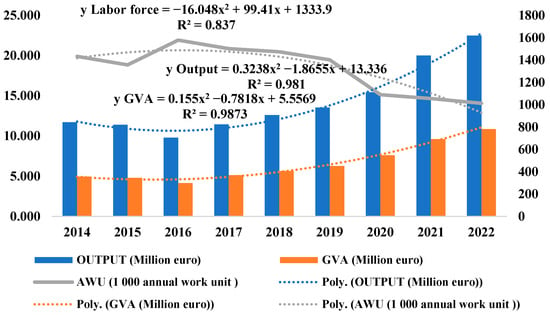
Figure 9.
Labour productivity in Romanian agriculture. Poli. = Polynomial trend line.
Labour productivity in Romania’s agriculture (calculated as the ratio of the value of agricultural production to the labour force) has an average growth rate of 8.50% against a background of a reduction in the labour force (−4.24%) and at a higher rate than the growth in the value of production (average annual rate of +3.90%). If we also take into account intermediate expenditure (the difference between the value of agricultural production and intermediate consumption), the gross value added has increased by an average of 5.62%. In this context, Romania’s labour productivity, calculated as the ratio between gross value added and labour force, shows an upward trend, with an average annual rate of +10.29%. Figure 3 shows labour productivity calculated as the value of agricultural industry output and gross value added for the period of 2014–2022.
These productivity increases are due to the reduction in labour in agriculture and the context of the poor modernisation of agricultural mechanisation. We cite the indicators of gross fixed capital formation (average growth rate is +13.38%) and net fixed capital formation (average rate −12.55%). Modernisation and the renewal of the technical base of mechanisation contribute to the efficient use of natural and human factors, in addition to other resources at Romania’s disposal (large number of farms and workforce) which also need to be made more efficient. Increasing economic, social and environmental efficiency in Romania’s agriculture, and making optimum use of the natural and human resources available to us, particularly labour and land, requires the promotion of quality factors, including knowledge, management, technical innovation, high-performance technologies and computerisation [42].
To make decisions in drawing up viable development strategies [35], decision makers need to know the main demographic indicators and the factors that determine population movement, since human resources and their level of training are the key factors in the economic, administrative and social–cultural development of local areas and communities, on the one hand, and factors of consumption, on the other.
After conducting the study, it can be considered that the first research hypothesis has been verified. It can also be considered that the decline in agricultural employment has accelerated in recent years, and that there are other influencing factors, such as effective universal factors associated with the increase in agricultural production technology. The population has declined sharply in recent years due to rural depopulation and the aging of the existing population. In addition, there is a labour shortage.
4.2. Linear Regression Model Regarding Labour Potential in Agriculture
For the analysis of the labour force potential in Romania’s agriculture, statistical data will be used on its dynamics, as well as on other characteristics that can constitute variables in the statistical analysis of the impact of the agricultural labour force on the effect indicators. Of the effect indicators, the most relevant was considered to be the production value of the agricultural branch (Figure 10).
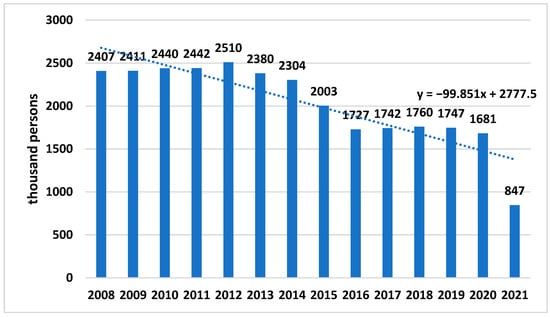
Figure 10.
Dynamics of agricultural workers in Romania. Source: processing based on NIS data.
According to the literature [22], labour laws as a whole only cover legal relationships based on individual employment contracts, but Romanian law also regulates many other employment relationships, which are more or less regulated by labour laws.
Regarding the quantitative potential of the labour force in Romanian agriculture, Figure 1 shows the decreasing dynamics of people working in agriculture. In 2008, about 2.4 million people worked in agriculture, representing 27.5% of the entire employed population at the national level. Then, in 2012, a peak of 2.51 million people working in agriculture was reached, representing almost 30% of the total employed population, but after this period, there was a major decline. In 2021, there were 847 thousand people working in agriculture in the last year, representing 11% of the employed population. Analysing the coefficient of the dynamic trend equation, it can be seen that on average, in the period analysed, each year, the number of agricultural workers decreased by about 100 thousand people. This decline may have several causes, such as the excessive ageing of the rural population, but especially of ex-farm managers, more than half of whom are bordering retirement age, or at a level of investment based on a single axis, namely the national rural development programme. But it should be noted that there is also a general downward trend in the agricultural workforce in other countries, given the technological and digital development of agriculture, leading to lower labour requirements.
Given the opposite dynamics of the two indicators analysed in Figure 11, with a similar but opposite rate of change, we can determine that average wage earnings in agriculture would influence vacancies. The total net average wage earning per person increased each year by 8.5%, from 183 monetary units (EUR) to 529 monetary units (EUR) over the period analysed; thus, the increase was almost 300%. Over time, with the increase in net income, there is a decrease in vacancies. This is at an average change rate of 8.4% per year, with the number of vacancies falling from 1585 to 507. Given these changes, we tested whether the link is strong and to what extent the indicators are influenced. It is observed that there is not a strong link between the indicators, with the change in vacancies being explained by the change in earnings of around 7%.
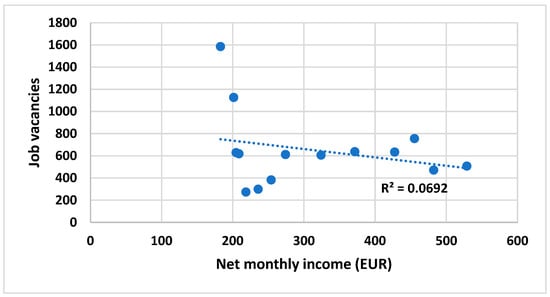
Figure 11.
Correlation between average net earnings of workers and job vacancies. Source: processing based on NIS data.
In regard to the qualitative potential of the labour force, Figure 12 shows the dynamics of people working in agriculture according to their level of education and according to the International Standard Classification of Education (ISCED).
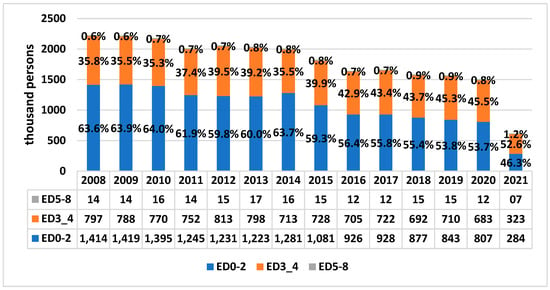
Figure 12.
Dynamics and structure of the agricultural labour force by education level. Source: processing based on EUROSTAT data.
It can be seen that according to the level of education, the majority of the population employed in agriculture in Romania has a Basic level of education (Basic). According to the ISCE, their share ranges from 46.3% to 63.6%, which subsequently decreases as more and more people have increased their level of education in the last year, with most workers in agriculture having an Intermediate level of education (Intermediate), i.e., 52.6%. There is an increase over the study period in the number of workers with an Intermediate level of education, from 35.8% in 2008 to 45.5% in 2021, and the greatest increase was recorded in the Advanced level of education, from 0.6% at the beginning of the period analysed, which is then doubled at the end of the period to 1.2%. Analysing the decrease in the labour force employed in agriculture at the general level and the decreases according to the level of education, it can be seen that for the first level of education, Basic (“ED0-2”), the decrease is the largest, with 1.13 million people (80%). Then, for the Intermediate level of education (“ED3_4”), the decrease was 474 thousand people (60%), and for the Advanced level of education (“ED5-8”), the decrease was the smallest, with 6.7 thousand people (48%).
Finally, to determine the quantitative and qualitative potential of the labour force and the impact of its dynamics, an effect indicator measuring the value of the agricultural sector’s production was used, the dynamics of which can be seen in Figure 13.
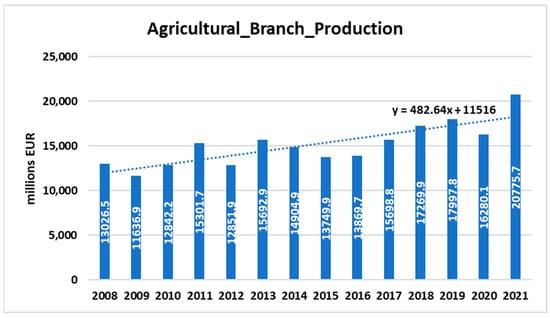
Figure 13.
Dynamics of the value of agricultural production in Romania. Source: processing based on NIS data.
Agriculture includes crop production, animal production, agricultural services and agricultural product processing. In total, in regard to the period under review, it ranged from EUR 13.03 billion to EUR 20.77 billion in the last year alone. On average, this value deviated by ±EUR 2.44 billion, a variation of ±16%. Although the value of production fluctuates from year to year, being directly subject to pedoclimatic factors directly affecting production and yield, an overall upward trend is observed, on average increasing by EUR 0.48 billion each year, or 3.65%. An external influence on this increase may also be the price of valorisation and the high level of inflation. However, we still want to determine whether the increasingly educated (skilled) labour force contributed to this increase.
The value of agricultural production is composed of crop production, animal production, the value of agricultural services and the value of processed products. Still, Romania is experiencing a decrease in the potential to generate added value. This is due to the fact that the primary sectors (the production of raw materials), i.e., the vegetable sector and the livestock sector, account for more than 90% of the production value. As far as crop production is concerned, its share varied between 61.3% and 71.2% on average. Over the whole period analysed, the value of crop production was 67.2% of the total branch. The value of livestock production varied between 20% and 28%, with the average for the period stabilising at 23.3% of the value of the entire agricultural sector. The production of agricultural services in Romania accounted for 1.4% of the total agricultural industry, and the value of processing in agriculture averaged 8% over the period under review.
To analyse the potential and impact of the labour force in the agricultural sector in Romania, further development of a linear regression model between the explained variable “the value of the agricultural production branch” and the exogenous variable “employed population by education level” is required.
First, the stationarity of the variables will be tested using the Dickey–Fuller statistical test. Figure 14 shows this test for the dependent variable, namely the value of the agricultural production branch.
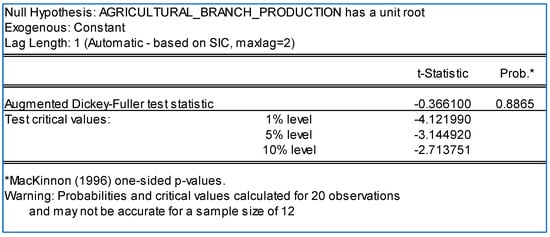
Figure 14.
Determining variable stationarity using the Standard Unit Root Test. Source: authors’ calculations (raw data source: NIS and Eurostat, processed in EViews 12 Student Version Lite).
By testing the stationariness of the dependent variable using the Standard Unit Root Test, the t-statistic value of the Dickey—Fuller test for this variable is very small, being non-representative, as can be seen from the probability level being well above the maximum accepted threshold of 5%.
To perform a statistical time series for this variable, the logarithm of the variables was used, and the stationarity test for this new variable (the log of the value of the agricultural production branch) can be seen in Figure 15.
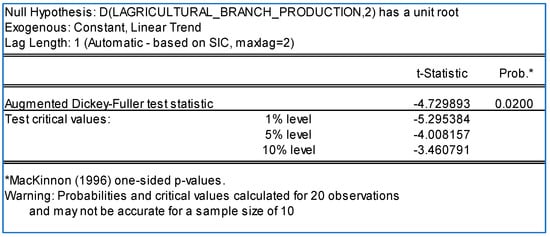
Figure 15.
Determining the stationarity of the logarithmic dependent variable using the Standard Unit Root Test. Source: authors’ calculations (raw data source: NIS and Eurostat, processed in EViews 12 Student Version Lite).
As can be seen from Figure 15, by logarithmising the data string of the deponent variable, it was possible to obtain a new data series, which is stationary according to the Standard Unit Root Test, with the level of the statistical parameter t of the Dickey–Fuller test being statistically representative and the probability level being 0.02 below the maximum accepted threshold of 0.05 (5%).
The independent variables were also analysed with respect to the stationariness of the data string and found to be non-stationary, and the same logarithm method was used for each independent variable.
Figure 16 shows the regression model between the dependent variable, the logarithm of the value of the agricultural production branch, and the independent variable: the logarithm of the employed population by education level.
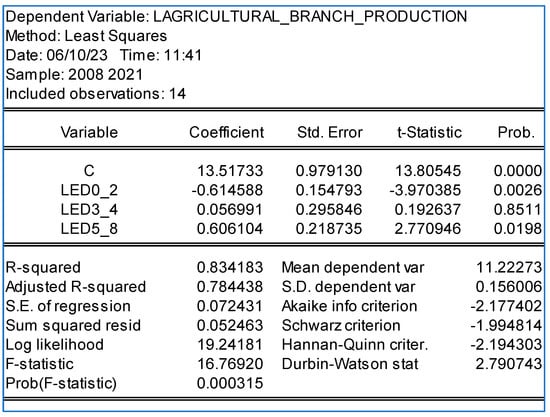
Figure 16.
Regression model results between the value of agricultural production and employed population by education levels (ED0_2; ED3_4; ED5_8). Source: authors’ calculations (raw data source: NIS and Eurostat, processed in EViews 12 Student Version Lite).
From the model presented above, it can be seen that unfortunately, it is not statistically validated, and that the level of the t-Statistic parameter for the second independent variable, namely the population employed in agriculture with a medium level of education (LED3_4), is statistically unrepresentative, with the probability value being above the maximum accepted level of 5%. Thus, we propose the elimination of this variable and the resumption of a model that considers the dependent variable and the two independent variables, namely the population employed in agriculture with a low and high level of education (Figure 17).
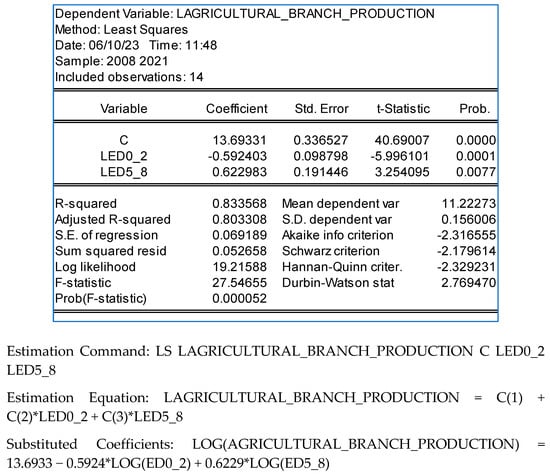
Figure 17.
Regression model results between the value of agricultural production and employed population by education levels (ED0_2; ED5_8). Source: authors’ calculations (raw data source: NIS and Eurostat, processed in EViews 12 Student Version Lite).
As can be seen, the coefficient of determination (R-squared) is 0.83, which indicates that 83% of the variation in the value of agricultural production is explained by the variation in the population employed in agriculture according to the level of education in the two steps (Basic and Advanced). The adjusted coefficient of determination (Adjusted R2) validates the model given the relatively small decrease between the R2 and the adjusted coefficient, from 83% to 80.3%.
Analysing the significance level (probability) of the coefficients, all of them have an error rate below 5%, so the results can be estimated with a probability of over 95%. The significance level of the F-statistic parameter is also adequate, being well below the maximum threshold of 5%, and the level of the F-statistic parameter exceeds the level of the F-critical parameter (for F-critical(0.05;2;11) = 3.98).
Analysing the values of the coefficients, the following relationships can be identified: a higher level of the population employed in agriculture with a low level of education (ED0-2) leads to an exponential decrease in the value of agricultural production, the coefficient being −0.59; and an increase in the population employed in agriculture with a higher education level (ED5-8) leads to an exponential increase in the value of agricultural production, with the coefficient being 0.62.
Regarding the level of autocorrelation between the residuals, analysing the value of the Durbin–Watson test, it is observed that it is 2.79, slightly higher than the recommended value of 2. Analysing in depth, for a significance level of 0.05 and with a number of 14 observations and k = 2, the critical values for the Durbin Watson test are d1 = 0.91 and d2 = 1.55; thus, compared to the possible situations (positive autocorrelation, indecision, independent, indecision and negative autocorrelation), the statistical value a Durbin Watson (DW) test of 2.79 falls between 4-d2 and 4-d1, representing a situation of indecision, but the residuals cannot be said to be autocorrelated (negative).
Continuing the testing of the residuals, in Figure 18, a table with the actual, fitted, and residual values, as well as the residual plot, can be seen.
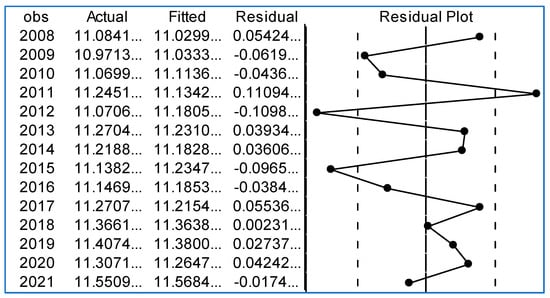
Figure 18.
Actual, fitted, residual table. Source: authors’ calculations (raw data source: NIS and Eurostat, processed in EViews 12 Student Version Lite).
According to the graph of the residuals, it can be seen that three residuals do not fall within the accepted limits and lead to a decrease in the value of the coefficient of determination, namely those of 2011, 2012 and 2015. There could also be an explanation in this sense, analysing Figure 12, these are the “threshold” years, when the population employed in agriculture decreased sharply compared to previous years. In the 2011–2012 period, the decrease in the employed population can be attributed to the economic crisis of that period, with massive redundancies in all sectors of activity, and in 2015, the decrease in the employed population can be attributed to the reduced salary. In 2016, the salary was restructured in Romania.
5. Discussion
Even if this topic is often addressed, according to the bibliometric analysis carried out in the first part of this paper, it is still an important issue in Romania, but also in other EU countries, as the agricultural workforce is becoming increasingly scarce, given the statistics and the advanced degree of ageing in rural areas.
This is also confirmed by the situation with vacancies; even if they have decreased in dynamics during the period under review, they are quite numerous and are not correlated with the level of earnings, which are increasing, thus confirming once again a shortage of available labour. The most plausible explanation for the decrease in vacancies is the replacement of manual labour with mechanised labour and the modernisation of production techniques.
Following the research carried out, it can be considered that the first research hypothesis is validated, and it can be considered that the population employed in agriculture is registering an accelerated decrease in recent years, with additional factors of influence in the case of Romania compared to the universally valid factor related to the increase in agricultural production technology. There has been a steep decline in recent years due to the depopulation of the countryside and the ageing of the existing population. In addition, there is a lack of labour availability.
Regarding the second research hypothesis, it was found that the level of wage earnings in agribusiness does not explain the dynamics of the number of vacancies in agribusiness. Even if the change was in the same proportion, but in opposite directions, as it is naturally and as has been identified in other research, when analysing the coefficient of determination, it is determined that the second hypothesis is invalidated, i.e., the change in the number of job vacancies is explained by a proportion of only 7% of the change in salary earnings, so it cannot be considered an influence between these variables.
The last research hypothesis is validated by the econometric model presented at the end of the research, i.e., the value of the agricultural sector output increases with the growth of the employed population educated to an Advanced level. There is always a small decrease in production value if the education level of the agricultural workforce is Intermediate rather than Basic.
In Romania, the main problems facing the sector are the ageing of the farming population, the exodus of young people to other countries, low education levels and low incomes. Developing training and education programmes for farmers, encouraging investment in farming/farm technology and innovation, supporting farmers through funding programmes, and creating partnerships between the public and private sectors are some examples of recommendations that can improve the agricultural workforce in Romania.
Romania’s agricultural performance is influenced by its integration into the global market. Understanding international trade dynamics and competitiveness is essential for sustained economic growth.
The contribution of the agricultural labour force in Romania to the sector’s economic performance is a complex interplay of various factors, including workforce size, productivity, government policies, and global market dynamics. A holistic approach that addresses challenges and capitalises on opportunities can contribute to the sustainable development of the agricultural sector.
The population employed in agriculture has been declining significantly in recent years in Romania, raising questions about the dynamics of the agricultural sector. At the same time, the level of wage earnings in agribusiness does not seem to fully explain this change, and the value of production in the sector seems to be influenced by the Advanced education of the employed population. By analysing these aspects together, we can better understand the complexity and challenges facing Romanian agriculture.
6. Conclusions
The bibliometric analysis provides a historical, contextual and evolutionary perspective on previous research as well as on the problematic factors in the field, linking the “agricultural workforce” to other factors such as climate change, economic growth, sustainability, education and income.
The results obtained reflect the interest and concerns of both researchers and the population regarding the agricultural sector. The review found that the literature covered topics as varied as self-employment, entrepreneurship, behaviour, investment, education, culture, farm workers, climate change, CO2 emissions, sustainability, agricultural mechanisation, food security and land use.
These conclusions emphasise the importance and diversity of approaches in agricultural research, reflecting both academic interest and societal concerns related to this vital sphere of the economy and environment.
The leading countries in the publication of scientific articles on the agricultural workforce are the USA (473 papers), China (460 papers) and England (106 papers).
The number of people employed in rural areas is showing a downward trend, with an accelerated pace in recent years, due to the decreasing number of people living in rural areas and the ageing population in these areas.
Given that the rates of change in net monthly earnings in agri-food, and that the number of job vacancies were similar but in opposite directions, we considered that these two variables could be correlated, but analysing the correlation coefficient did not uncover a strong link between them. Thus, wage earnings did not impact vacancies, earnings increased due to the general increase in wages in the whole economic sector, and vacancies decreased due to the lack of labour supply on the market, as well as the fact that production technologies have become increasingly modern and automated.
Analysing the population employed in agriculture by education level, it decreased in line with the general trend. However, except for the last level of education, the Advanced one recorded an increasing share of the total. At the same time, even if the population with Intermediate education has decreased, its share has also increased. Therefore, a higher level of education among the workforce in agriculture is noticeable with time, which can be considered as qualitative potential.
When examining the demographic composition of the workforce engaged in Romanian agriculture in relation to the scale of agricultural output, a statistically significant observation emerges; there exists a likelihood exceeding 95% that the educational attainment of the labour force significantly impacts the value of agricultural production. Moreover, a notable finding suggests that augmenting the proportion of agriculturally employed individuals with Advanced education levels correlates positively with substantial increments in production values.
The population employed in agriculture has been declining significantly In recent years. This phenomenon can partly be explained by technological changes and the modernisation of the agricultural sector. The use of advanced technologies and the mechanisation of agricultural processes have led to a lower demand for labour in agriculture. Thus, many people have turned to other economic sectors in search of better opportunities and higher earnings.
Interestingly, the level of wage earnings in agribusiness does not seem to be the only factor explaining the dynamics of the number of vacancies. This phenomenon can be interpreted in the context of demographic change and labour migration. It is possible that some regions are more affected by labour migration to urban sectors or to other countries, which could leave vacancies behind.
In contrast, we see an interesting correlation between the increase in the value of output in the agricultural sector and the increase in the number of employed people with Advanced education. Advanced education can play a key role in the implementation of innovative farming practices, efficient management and the adoption of advanced technologies. A workforce with an Advanced education can contribute to increasing the competitiveness of the agricultural sector in the global market.
In conclusion, the evolution of the population employed in agriculture in Romania is influenced by a variety of factors, such as technological modernisation, labour migration and educational attainment. It is essential to address these challenges through an integrated approach, including investment in education, support for the modernisation of the agricultural sector and adaptation to economic and technological change. In this way, Romanian agriculture can evolve in a sustainable and competitive way in the long term.
To present the research results objectively, it is important to mention some limitations of the research. We believe that the following aspects can be included within the limits of the research: the use of several databases that may have a different methodology of data collection, the relatively short period of analysis and the 14 years analysed being the lower limit for which an econometric regression model is performed. At the same time, it should be mentioned that the phenomenon of autocorrelation between residuals could not be eliminated with certainty, with the situation being characterised as indecision.
Author Contributions
Conceptualisation, A.U. and I.L.P.; methodology, I.L.P.; software, M.C.S.; validation, A.U., M.C.S. and I.L.P.; formal analysis, I.L.P.; investigation, M.C.S.; resources, A.U.; data curation, M.C.S.; writing—original draft preparation, M.C.S.; writing—review and editing, I.L.P.; visualisation, M.C.S.; supervision, A.U.; project administration, A.U.; funding acquisition, I.L.P. All authors have read and agreed to the published version of the manuscript.
Funding
This research received no external funding.
Institutional Review Board Statement
Not applicable.
Informed Consent Statement
Not applicable.
Data Availability Statement
The data presented in this study are available on request from the corresponding author.
Conflicts of Interest
The authors declare no conflict of interest.
References
- Gouda, S.; Kerry, R.G.; Das, G.; Paramithiotis, S.; Shin, H.S.; Patra, J.K. Revitalization of plant growth promoting rhizobacteria for sustainable development in agriculture. Microbiol. Res. 2018, 206, 131–140. [Google Scholar] [CrossRef]
- Gavrilescu, D.; Gavrilescu, C. From Subsistence to Efficiency in the Romanian Agriculture during Transition. (No. 689-2016-47294). 2007. Available online: https://ageconsearch.umn.edu/record/7814/?ln=en (accessed on 13 March 2023).
- Dumitru, E.A.; Marius Mihai MI, C.U.; Tudor, V.C. Conceptual approaches regarding the Romanian rural area. Sci. Pap. Manag. Econ. Eng. Agric. Rural. Dev. 2019, 19, 121–128. [Google Scholar]
- Leoveanu-Soare, B.E.; Petre, L.I.; Micu, M.M. Social and economic aspects regarding the development of agriculture in Romania. Sci. Pap. Manag. Econ. Eng. Agric. Rural. Dev. 2020, 20, 281–287. [Google Scholar]
- Popescu, A.; Tindeche, C.; Marcuță, A.; Marcuță, L.; Honțuș, A.; Angelescu, C. Labor force in the European Union agriculture-Traits and tendencies. Econ. Anal. 2021, 20, 27. [Google Scholar]
- Mélypataki, G. Characteristics of Seasonal and Public Employment Relationships Linked to Agriculture. AGRÁR-És Környezetjog 2017, 23, 64–90. [Google Scholar] [CrossRef]
- Istudor, N.; The Bucharest University of Economic Studies; Ion, R.A.; Petrescu, I.E.; Hrebenciuc, A. Agriculture and the twofold relationship between food security and climate change. Evidence from Romania. Amfiteatru Econ. 2019, 21, 285–293. [Google Scholar] [CrossRef]
- Mateoc-Sîrb, N.; Mateoc, T.; Mănescu, C.; Grad, I. Research on the labour force from Romanian agriculture. Sci. Pap. Ser. Manag. Econ. Eng. Agric. Rural. Dev. 2014, 14, 215–218. [Google Scholar]
- Dumitru, E.A.; Ursu, A.; Tudor, V.C.; Micu, M.M. Sustainable Development of the Rural Areas from Romania: Development of a Digital Tool to Generate Adapted Solutions at Local Level. Sustainability 2021, 13, 11921. [Google Scholar] [CrossRef]
- Tocco, B.; Sophia, D.; Alastair, B. Labour adjustments in agriculture: Evidence from Romania. Stud. Agric. Econ. 2012, 116, 67–73. [Google Scholar] [CrossRef]
- Micu, M.M.; Dinu, T.A.; Fintineru, G.; Tudor, V.C.; Stoian, E.; Dumitru, E.A.; Stoicea, P.; Iorga, A. Climate Change—Between “Myth and Truth” in Romanian Farmers’ Perception. Sustainability 2022, 14, 8689. [Google Scholar] [CrossRef]
- Otiman, P.I. Sustainable Development Strategy of Agriculture and Rural Areas in Romania on Medium and Long Term-Rural Romania XXI–. Agric. Econ. Rural. Dev. 2008, 5, 4–18. [Google Scholar]
- Butu, A.; Rodino, S.; Butu, M.; Ion, R. Bioeconomy related perspectives for boosting agriculture development in Romania. Proc. Int. Conf. Bus. Excell. 2020, 14, 548–558. [Google Scholar] [CrossRef]
- Iancu, T.; Tudor, V.C.; Dumitru, E.A.; Sterie, C.M.; Micu, M.M.; Smedescu, D.; Marcuta, L.; Tonea, E.; Stoicea, P.; Vintu, C.; et al. A Scientometric Analysis of Climate Change Adaptation Studies. Sustainability 2022, 14, 12945. [Google Scholar] [CrossRef]
- Istrate, M.; Horea-Serban, R.I.; Stoleriu, O.M. Labour Force, Gender and Regional Disparities in Romanian Agriculture. In Proceedings of the 3rd International Multidisciplinary Scientific Conference on Social Science and Arts SGEM 2016, Albena, Bulgaria, 22–31 August 2016. [Google Scholar]
- Tudor, M.M. Small scale agriculture as a resilient system in rural Romania. Stud. Agric. Econ. 2015, 117, 27–34. [Google Scholar] [CrossRef][Green Version]
- Walenty, P.; Fabisiak, A. Changes in labour force resources in agriculture in the Central and Eastern European Countries as a result of accession to the European Union. J. Agribus. Rural. Dev. 2007, 6, 109–117. [Google Scholar]
- Smędzik-Ambroży, K.; Agnieszka, S. Efficiency and technical progress in agricultural productivity in the European Union. Pr. Nauk. Uniw. Ekon. We Wrocławiu 2019, 63, 114–126. [Google Scholar] [CrossRef]
- Dong, H. Rural labour force transition and patterns of urbanization in China. Asia-Pac. Popul. J. 1989, 4, 41–51. [Google Scholar]
- Popescu, A.; Dinu, T.A.; Stoian, E.; Serban, V. Efficiency of labor force use in the European Union’s agriculture in the period 2011–2020. Sci. Pap. Ser. Manag. Econ. Eng. Agric. Rural. Dev. 2021, 21, 659–672. [Google Scholar]
- Steensland, A.; Zeigler, M. Productivity in agriculture for a sustainable future. In The Innovation Revolution in Agriculture; Springer: Berlin/Heidelberg, Germany, 2021. [Google Scholar]
- Zhang, Y.; Xu, D. Service on the rise, agriculture and manufacturing in decline: The labor market effects of high-speed rail services in Spain. Transp. Res. Part A Policy Pract. 2023, 171, 103617. [Google Scholar] [CrossRef]
- Liu, S.; Wang, B. The decline in agricultural share and agricultural industrialization—some stylized facts and theoretical explanations. China Agric. Econ. Rev. 2022, 14, 469–493. [Google Scholar] [CrossRef]
- Qi, Y.; Tang, C. Effect of labor migration on cultivated land planting structure in rural China. Trans. Chin. Soc. Agric. Eng. 2017, 33, 233–240. [Google Scholar]
- Ren, G.; Zhu, X.; Feng, S. The Impact of Migration on Farm Performance: Evidence from Rice Farmers in China. Agriculture 2023, 13, 708. [Google Scholar] [CrossRef]
- Knickel, K.; Ashkenazy, A.; Chebach, T.C.; Parrot, N. Agricultural modernization and sustainable agriculture: Contradictions and complementarities. Int. J. Agric. Sustain. 2017, 15, 575–592. [Google Scholar] [CrossRef]
- Shan, Z.; Wang, F.; Tao, Y.; Feng, Y. Research on the Present Situation, Problems and Countermeasures Under the Integration of Digital Economy and Agricultural Economy. Front. Bus. Econ. Manag. 2022, 6, 78–81. [Google Scholar] [CrossRef]
- Chi, H.; Yeh, H.; Guo, T. Salary or job interest? How salary and job interest moderates the willingness to apply for a job. Asia-Pac. J. Bus. Adm. 2018, 10, 64–78. [Google Scholar] [CrossRef]
- Motofeanu, M.; Petre, I.L.; Dumitru, E.A.; Sterie, M.C. Romania’s Agricultural Labour Force–Trends, Mutations And Disturbances. Int. J. Innov. Sci. Res. Technol. 2022, 7, 1683–1691. [Google Scholar]
- Benos, N.; Karagiannis, S. Do education quality and spillovers matter? Evidence on human capital and productivity in Greece. Econ. Model. 2016, 54, 563–573. [Google Scholar] [CrossRef]
- Blanco, C.; Raurich, X. Agricultural composition and labor productivity. J. Dev. Econ. 2022, 158, 102934. [Google Scholar] [CrossRef]
- Lazear, E.P.; Shaw, K.; Hayes, G.; Jedras, J. Productivity and Wages: What Was the Productivity–Wage Link in the Digital Revolution of the Past, and What Might Occur in the AI Revolution of the Future. In 50th Celebratory Volume (Research in Labor Economics, Vol. 50); Polachek, S.W., Tatsiramos, K., Eds.; Emerald Publishing Limited: Bingley, UK, 2023; pp. 191–253. [Google Scholar]
- Faryna, O.; Pham, T.; Talavera, O.; Tsapin, A. Wage and unemployment: Evidence from online job vacancy data. Journal of comparative economics 2022, 50(1), 52–70. [Google Scholar] [CrossRef]
- Delano, R.B. The farmer as an innovative survivor. In Agriculture in the Twenty-First Century; Rosenblum, J.W., Ed.; John Wiley and Sons: New York, NY, USA, 1983; p. 187. [Google Scholar]
- Dumitru, E.A.; Micu, M.M.; Sterie, C.M. The key to the development of agricultural cooperatives in Romania from the perspective of those who run them. Outlook Agric. 2022, 52(1), 89–100. [Google Scholar] [CrossRef]
- Erol, I.; Mutuş, B.; Ayaz, N.D.; Stowell, J.D.; Sırıken, B. Food Safety Awareness, Changes in Food Purchasing Behaviour and Attitudes towards Food Waste during COVID-19 in Türkiye. Foods 2023, 12, 4396. [Google Scholar] [CrossRef]
- Southworth, H.M.; Johnston, B.F. Agricultural Development and Economic Growth; Cornell University Press: Ithaca, NY, USA, 1968; pp. 153–154. [Google Scholar]
- Băneș, A.; Goșa, V.; Raicov, M.; Orboi, M. Migrația populației din România în perioada 2012–2016 [Population migration in Romania between 2012–2016]. In Piețele Agricole și Spațiul Rural în Contextual Modernizării și Simplificării Politicii Agricole Comune [Agricultural Markets and the Countryside in the Context of Modernisation and Simplification of the Common Agricultural Policy]; Romanian Academy Publishing House: Bucharest, Romania, 2019; p. 466. ISBN 978-973-27-3127-7. [Google Scholar]
- European Commission-Directorate-General for Agriculture and Rural Development (DG ARD). Available online: https://agridata.ec.europa.eu/extensions/DashboardIndicators/FarmIncome.html (accessed on 13 March 2023).
- Eurostat–Statistics Explained, Farmers and the Agricultural Labour Force–Statistics. Available online: https://ec.europa.eu/eurostat/statistics-explained/index.php?title=Farmers_and_the_agricultural_labour_force_-_statistics (accessed on 13 March 2023).
- University "Alexandru Ioan Cuza", Statistica Multivariată, Noțiuni Teoretice [Multivariate Statistics, Theoretical Concepts]. Available online: https://profs.info.uaic.ro/~val/statistica/StatWork_7.pdf (accessed on 13 March 2023).
- Vallasek, M. ‘Romania: Development of Labor Law Under the Banner of Flexibility’. In Fundamentals of Labor Law in Central Europe; Jakab, N., Ed.; Central European Academic Publishing: Budapest, Hungary, 2022; pp. 57–79. [Google Scholar] [CrossRef]
Disclaimer/Publisher’s Note: The statements, opinions and data contained in all publications are solely those of the individual author(s) and contributor(s) and not of MDPI and/or the editor(s). MDPI and/or the editor(s) disclaim responsibility for any injury to people or property resulting from any ideas, methods, instructions or products referred to in the content. |
© 2023 by the authors. Licensee MDPI, Basel, Switzerland. This article is an open access article distributed under the terms and conditions of the Creative Commons Attribution (CC BY) license (https://creativecommons.org/licenses/by/4.0/).